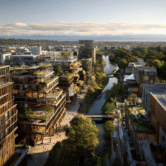
“Thunderstorms dumped heavy rain and kicked up high winds across central Nevada on Thursday, flooding the streets and casinos of Las Vegas.” Yes, water was leaking out of light fixtures in the ceilings of some of Vegas’ billion dollar casinos.
How is that we can drive any new car (no matter the price) in rain and wind storms at speeds far exceeding the highest recorded winds of 71 mph in Las Vegas and our cars don’t leak but our billion dollar casinos leak and they are standing still?
Unfortunately, casino owners, developers, and contractors place more value on cost of construction and high-end finishes rather than designing and constructing quality building enclosures.
BUILDING ENCLOSURE – DEFINITION
According to University of Waterloo and RDH Building Science’s John Straube, a building enclosure, also called a building envelope, shelters its inhabitants by physically separating the exterior environment from the interior environment. Building Science Corp states, “physically, the typical building enclosure usually consists of the following components: the base floor system(s); the below-grade wall system (s); the above-grade wall system(s); windows (fenestration) and doors; and the roof system(s).”

In 1963, Hutchson states that the principle requirements of a building enclosure are to:
1. Control heat flow
2. Control air flow
3. Control water vapor flow
4. Control rain penetration
5. Control light, solar and other radiation
6. Control noise
7. Control fire
8. Provide strength and rigidity
9. Be durable
10. Be aesthetically pleasing
11. Be economical
In a great article for Whole Building Design Guide, Ted Kesik, Professor of Building Science at University of Toronto John H. Daniels Architecture, Landscape, and design, added additional objectives that have been adopted over the years, such as consideration of the environmental impacts associated with building methods and materials, and the need to provide safe and secure buildings. See Ted’s table below for current requirements and parameters.

In High Performance Building Enclosures, Dr. John Straube outlines the ‘ideal’ wall for the purpose of helping designers conceptualize how a building enclosure’s components should work together as a system. The sequence of layers represents a conceptual, climate-neutral approach with a scientific placement of the control layers that shows designers clearly how they interact and what functions each layer performs.
In the diagram, the cladding is on the outside, followed by the insulation, then the water, air, and vapor control layers, then the building structure and interior finishes. However, the perfect wall is a blueprint meant to remind designers of the total goals of a wall system; as such, they can use it to check systems that do not follow the configuration specified in the schematic:

“The key to high performance building enclosures is that the four control layers continuous be provided and they be as continuous and unbroken as possible across penetrations and transitions.”
HOW DO YOU KNOW WHEN YOU HAVE DESIGNED A QUALITY AIR AND WATER BARRIER WITHIN THE BUILDING ENCLOSURE?
As Randy Williams writes in Fine HomeBuilding, “Make sure the air control layer will be continuous. The pen test is a good way to determine if you’ve missed something. Take a red pen and trace around any section drawing of the house—the pen should never leave the paper as you outline the location of the air control layer. How is the foundation sealed to the wall? The wall to the window or door? The wall to the roof or ceiling? And so on. If you can’t name the materials that are keeping the air barrier continuous at any given point, you have a potential air leak.”

The pen test for the liquid water control layer is shown here. Tracing the blue line around the building enclosure, you can see all the components that make up the control layer for liquid water. Image Credit: US Environmental Protection Agency
BUILDING ENCLOSURES AND INDOOR AIR QUALITY (IAQ)
As Bill Hayward and H3 points out, “way back in 1989, a special legislative committee on indoor air pollution in Massachusetts found indoor air pollution accounts for up to 50 percent of all illnesses. Today, the EPA considers indoor air quality among the top five risks to public health, noting that Americans typically spend about 90% of their time indoors where the environment can be six times more polluted than outside.”
So how do we improve indoor air quality?
By building a very tight building enclosure to control heat, air, water, moisture, solar radiation, and outdoor pollutants and adding ventilation systems and radiant heating and cooling systems, we transform the indoor experience by not only helping to optimize personal comfort in the home but, more importantly, we can manage other exterior elements like outdoor pollutants – smog, smoke, car exhausts, sprayed pesticides, and smoke from wildfires. Thus, we can build healthy homes and buildings.
CONSTRUCTING A QUALITY BUILDING ENCLOSURE
As Emily Hopps and Peter Babaian of SGH write in Building Design + Construction, building enclosure commissioning—BECx—is intended to assure building quality by establishing an explicit process to verify that a building enclosure is designed and constructed to meet the owner’s objectives. The concept of building enclosure commissioning has been around for several decades, but it has not been well defined, understood, or utilized. The following eight strategies will help Building Teams sort through the various building enclosure commissioning guidelines and use BECx in a logical and cost-effective way.
1. Make building enclosure commissioning a process.
2. Retain an independent third party as BECx authority.
3. Define the owner’s project requirements (OPR).
4. Align the building envelope commissioning scope with the OPR and the project’s complexity.
5. Produce a written BECx plan.
6. Plan design reviews for optimum impact.
7. Establish enclosure system performance metrics during the design phase.
8. Monitor construction early and regularly.
I would also emphasize utilizing blower door testing and infrared cameras.

CONCLUSION
Building enclosures are one of the key elements of a building but their design, construction, commissioning, and quality are often overlooked because of added cost to build right or because they are “behind the wall” so more emphasis is placed on high-end interior and exterior finishes that are seen by the customers, tenants, inhabitants, or the passerby; however, to improve comfort, indoor air quality issues, fight Climate Change, and stop leaks of air and moisture like this one in Las Vegas, we need to acknowledge its monumental importance.
All the Best,
Tyson Dirksen & The Evolve Team



